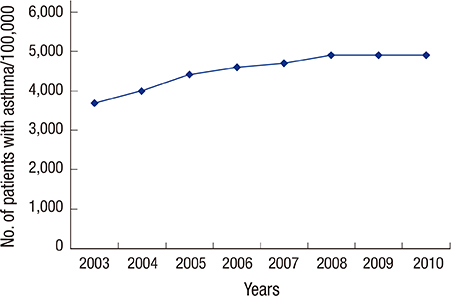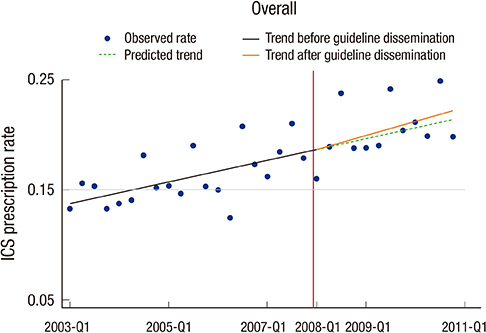J Korean Med Sci.
2015 Aug;30(8):1048-1054. 10.3346/jkms.2015.30.8.1048.
The Effect of Asthma Clinical Guideline for Adults on Inhaled Corticosteroids PrescriptionTrend: A Quasi-Experimental Study
- Affiliations
-
- 1Department of Family Medicine, Seoul National University Hospital, Seoul, Korea. belong.cho@gmail.com
- 2College of Medicine, Kyung Hee University, Seoul, Korea.
- 3Advanced Institutes of Convergence Technology, Seoul National University, Suwon, Korea.
- 4Institute on Aging, Seoul National University College of Medicine, Seoul, Korea.
- 5Department of Social and Preventive Medicine, Inha University School of Medicine, Incheon, Korea.
- KMID: 2164498
- DOI: http://doi.org/10.3346/jkms.2015.30.8.1048
Abstract
- In order to increase inhaled corticosteroid (ICS) use and to reduce hospitalization, emergency department visits and ultimately the economic burden of asthma, "Korean Asthma Management Guideline for Adults 2007" was developed. To assess the guideline effects on physician's ICS prescription for asthma, we conducted segmented regression and multilevel logistic regression using National Health Insurance claims database of outpatient visits from 2003 to 2010. We set each quarter of a year as a time unit and compared ICS prescription between before and after guideline dissemination. A total of 624,309 quarterly visits for asthma was observed. The ICS prescription rate before and after guideline dissemination was 13.3% and 16.4% respectively (P < 0.001). In the segmented regression, there was no significant guideline effect on overall ICS prescription rate. In multilevel logistic regression analyses, the effect of guideline on overall ICS prescription was not significant (odds ratio, 1.03; 95% CI, 1.00-1.06). In subgroup analysis, ICS prescription increased in secondary care hospitals (odds ratio, 1.15; 95% CI, 1.02-1.30) and in general hospitals (odds ratio, 1.10; 95% CI, 1.04-1.16). However, in primary clinics, which covered 81.7% of asthma cases, there was no significant change (odds ratio, 0.98; 95% CI, 0.94-1.02). From the in-depth interview, we could identify that the reimbursement criteria of the Health Insurance Review and Assessment Service and patient's preference for oral drug were barriers for the ICS prescription. The domestic asthma clinical guideline have no significant effect on ICS prescription, especially in primary clinics.
Keyword
MeSH Terms
-
Administration, Inhalation
Adrenal Cortex Hormones/*administration & dosage
Allergy and Immunology/standards
Anti-Inflammatory Agents/administration & dosage
Asthma/*drug therapy/*epidemiology
Drug Prescriptions/*statistics & numerical data
Guideline Adherence/*utilization
Humans
*Practice Guidelines as Topic
Prevalence
Pulmonary Medicine/standards
Republic of Korea/epidemiology
Treatment Outcome
Adrenal Cortex Hormones
Anti-Inflammatory Agents
Figure
Reference
-
1. Eder W, Ege MJ, von Mutius E. The asthma epidemic. N Engl J Med. 2006; 355:2226–2235.2. Weiss KB, Sullivan SD. The health economics of asthma and rhinitis. I. Assessing the economic impact. J Allergy Clin Immunol. 2001; 107:3–8.3. Dal Negro R, Berto P, Tognella S, Quareni L. Global Outcomes in Lung Disease Study Group. Cost-of-illness of lung disease in the TriVeneto Region, Italy: the GOLD Study. Monaldi Arch Chest Dis. 2002; 57:3–9.4. Kim CY, Park HW, Ko SK, Chang SI, Moon HB, Kim YY, Cho SH. The financial burden of asthma: a nationwide comprehensive survey conducted in the republic of Korea. Allergy Asthma Immunol Res. 2011; 3:34–38.5. Lee YH, Yoon SJ, Kim EJ, Kim YA, Seo HY, Oh IH. Economic burden of asthma in Korea. Allergy Asthma Proc. 2011; 32:35–40.6. Global Initiative for Asthma (GINA). Global strategy for asthma management and prevention (updated 2012). 2012. accessed on June 29 2015. Available at http://www.ginasthma.org.7. Adams RJ, Fuhlbrigge A, Guilbert T, Lozano P, Martinez F. Inadequate use of asthma medication in the United States: results of the asthma in America national population survey. J Allergy Clin Immunol. 2002; 110:58–64.8. Cazzoletti L, Marcon A, Janson C, Corsico A, Jarvis D, Pin I, Accordini S, Almar E, Bugiani M, Carolei A, et al. Therapy and Health Economics Group of the European Community Respiratory Health Survey. Asthma control in Europe: a real-world evaluation based on an international population-based study. J Allergy Clin Immunol. 2007; 120:1360–1367.9. Lai CK, De Guia TS, Kim YY, Kuo SH, Mukhopadhyay A, Soriano JB, Trung PL, Zhong NS, Zainudin N, Zainudin BM, et al. Asthma Insights and Reality in Asia-Pacific Steering Committee. Asthma control in the Asia-Pacific region: the Asthma Insights and Reality in Asia-Pacific Study. J Allergy Clin Immunol. 2003; 111:263–268.10. Korean Academy of Medical Sciences, Korean Academy of Tuberculosis and Respiratory Diseased & Korean Academy of Asthma, Allergy and Clinical Immunology. Korean Asthma Management Guideline for Adults 2007. accessed on June 29 2015. Available at http://guideline.or.kr/guideline/search.php?mode=search&type=2&Msid=28&Fsid=667.11. Kim S, Kim J, Kim K, Kim Y, Park Y, Baek S, Park SY, Yoon SY, Kwon HS, Cho YS, et al. Healthcare use and prescription patterns associated with adult asthma in Korea: analysis of the NHI claims database. Allergy. 2013; 68:1435–1442.12. Chun CB, Kim SY, Lee JY, Lee SY. Republic of Korea: health system review. Health Syst Transit. 2009; 11:1–184.13. Lazarus SC. Clinical practice. Emergency treatment of asthma. N Engl J Med. 2010; 363:755–764.14. World Health Organization, Ministry of Health and Welfare Republic of Korea. Republic of Korea health service delivery profile. 2012. accessed on Jung 29 2015. Available at http://www.wpro.who.int/health_services/service_delivery_profile_republic_of_korea.pdf.15. Wagner AK, Soumerai SB, Zhang F, Ross-Degnan D. Segmented regression analysis of interrupted time series studies in medication use research. J Clin Pharm Ther. 2002; 27:299–309.16. Sin DD, Tu JV. Underuse of inhaled steroid therapy in elderly patients with asthma. Chest. 2001; 119:720–725.17. Bae YJ, Kim TB, Jee YK, Park HW, Chang YS, Cho SH, Cho YS, Moon HB. Severe asthma patients in Korea overestimate their adherence to inhaled corticosteroids. J Asthma. 2009; 46:591–595.18. Lopez G, Wyatt L. Asthma prevalence, barriers to effective treatment, and current policy recommendations for the State of California. California. 2002 Educational Tour Series. California Research Bureau. Sacramento: California State Library, California Research Bureau;2003. accessed on June 29 2015. Available at https://www.library.ca.gov/crb/03/04/03-004.pdf.19. Horne R. Compliance, adherence, and concordance: implications for asthma treatment. Chest. 2006; 130:65s–72s.20. Kelloway JS, Wyatt RA, Adlis SA. Comparison of patients' compliance with prescribed oral and inhaled asthma medications. Arch Intern Med. 1994; 154:1349–1352.21. Chambers CV, Markson L, Diamond JJ, Lasch L, Berger M. Health beliefs and compliance with inhaled corticosteroids by asthmatic patients in primary care practices. Respir Med. 1999; 93:88–94.22. Sun YH, Eun BW, Sim SY, Cho KH, Ryoo E, Cho DY, Son DW, Tchah H, Jeon IS. Poor adherence and reasons for nonadherence to the asthma guidelines among pediatricians in Korea. Asian Pac J Allergy Immunol. 2010; 28:147–154.23. Wisnivesky JP, Lorenzo J, Lyn-Cook R, Newman T, Aponte A, Kiefer E, Halm EA. Barriers to adherence to asthma management guidelines among inner-city primary care providers. Ann Allergy Asthma Immunol. 2008; 101:264–270.24. Cabana MD, Ebel BE, Cooper-Patrick L, Powe NR, Rubin HR, Rand CS. Barriers pediatricians face when using asthma practice guidelines. Arch Pediatr Adolesc Med. 2000; 154:685–693.25. Cho SH, Park HW, Rosenberg DM. The current status of asthma in Korea. J Korean Med Sci. 2006; 21:181–187.26. Cho SH, Kim YK, Chang YS, Kim SS, Min KU, Kim YY. Asthma insights and reality in Korea. Korean J Med. 2006; 70:69–77.27. Milchak JL, Carter BL, James PA, Ardery G. Measuring adherence to practice guidelines for the management of hypertension: an evaluation of the literature. Hypertension. 2004; 44:602–608.28. American College of Chest Physicians, American Academy of Allergy, Asthma and Immunology, American College of Allergy Asthma & Immunology. Quick reference guide for clinicians: systematic review of the evidence regarding potential complications of inhaled steroid use in asthma. Ann Allergy Asthma Immunol. 2004; 92:291–293.29. Kang HY, Park CS, Bang HR, Sazonov V, Kim CJ. Effect of allergic rhinitis on the use and cost of health services by children with asthma. Yonsei Med J. 2008; 49:521–529.30. Park CS, Kang HY, Kwon I, Kang DR, Jung HY. Cost-of-illness study of asthma in Korea: estimated from the Korea National Health insurance claims database. J Prev Med Public Health. 2006; 39:397–403.
- Full Text Links
- Actions
-
Cited
- CITED
-
- Close
- Share
- Similar articles
-
- Inhaled Corticosteroids Is Not Associated with the Risk of Pneumonia in Asthma
- An experimental asthma exacerbation following discontinuation of inhaled corticosteroids treatment in patients with controlled asthma
- Inhaled Corticosteroids in Asthma
- Treatment of mild asthma: Is it necessary to keep regular inhaled corticosteroids?
- Pharmacogenomic Approaches to Asthma Treatment




